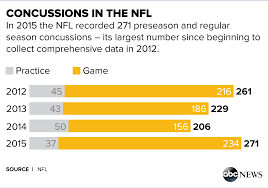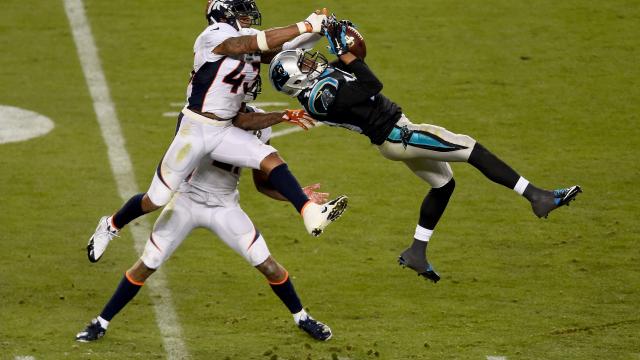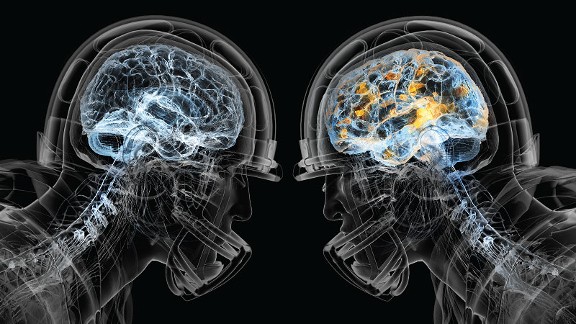Frequent Concussions Spur New Rules
BASH, like professional sports, has raised its awareness of head injuries. While football is in the national spotlight, cheerleaders have suffered the most concussions at BASH.
February 12, 2016
In last Sunday’s Super Bowl between the Carolina Panthers and the Denver Broncos, Panthers linebacker Thomas Davis played the game with a broken arm. The arm, which was wrapped in a heavy cast, was injured two weeks ago and was inserted with one plate and eleven screws.
On the other hand, Panthers wide receiver Corey “Philly” Brown suffered a concussion in the third quarter and did not return to action.
The extra caution for the head injury shows the impact of better concussion awareness and new protocols — affecting not only the professional sports world but also athletes here at BASH and in youth sports.
“Concussions have changed my life and the way I perceive everything,” said former BASH football player junior Mike Porreca, who has suffered three concussions.
The Injuries
A concussion is a traumatic brain injury that is caused by a blow to or the shaking of the head. Symptoms include headache, confusion, memory loss, nausea, vomiting, and dizziness. There are more than 3 million cases in the U.S. annually. Many of these concussions are sports related, and this has led many people to have different opinions on player safety during competition.
Second-impact Syndrome, one of the biggest concerns, occurs when a person returns to action before the brain is fully healed from their first concussion. The brain swells rapidly and catastrophically, and the second concussion may be even more severe than the first.
Many popular professional football players suffered concussions this past season, including Sam Bradford, Ben Roethlisberger, DeAndre Hopkins and Darrelle Revis. Some passed the league protocol and did not miss a game. On the other hand, some have had to miss many games as a result of the new multi-step concussion protocol adopted by the NFL in 2013. Colts running back Tyler Varga missed ten games from a concussion suffered in week three.
On January 29th, the NFL released its official concussion statistics for this past season. Concussions saw a 32 percent spike as the number rose from 206 in 2014 to 271 in 2015.

The Impact at BASH
Head injuries are not just a concern in professional and college sports; they have come to the forefront in high school and youth athletics. This is especially true here at BASH. Many concussions have been diagnosed in various sports.
As a result, concussion treatment is an important responsibility of the training staff here at BASH. The trainers have specific protocols and guidelines for when a Bear or Lady Bear suffers a blow to the head.
“The first thing we do when we suspect someone has sustained a concussion is look for symptoms,” said BASH Head Trainer Donna Harmon.
After looking for symptoms, the trainers perform a Standardized Assessment of Concussion (SAC) test, to further diagnose the athletes head injury. The test includes saying things in reverse order, and testing reaction times of the patient.
Once the concussion is diagnosed, the patient is not allowed to take medications such as Advil or Alieve, Harmon said. “We discourage medication so victims can see if their concussion symptoms are worsening or improving. If worsening, we encourage you to go to the hospital.”
Harmon said cheerleaders suffered the most concussions of any sport at BASH last year.
BASH cheerleader Meghan Wilhelm has suffered two concussions from the sport. The first time, she was kicked in the side of the head, and fell and hit the other side of her head on someone’s knee, she said. The second time, she passed out in a stunt and hit her head on the ground.
“The first concussion was a lot more painful than the second,” she said. “The first one I was in a lot of pain for the first night, which I spent mostly in the hospital.”
“I had bad headaches for a month and a half later. The second one was a lot less severe and manageable.”
Despite the improvement of helmets and tackling techniques, concussions also still plague youth football.
Former BASH football player Mike Porreca, who has suffered three concussions, said, “People do not understand that you are never finished dealing with your concussion. Once you have one you become more susceptible to another one and it just goes on and on. Eventually as you get more and more, your brain starts to shut down and you can’t really process as much as you could.”

Head Injuries and Soccer
While sports like football, ice hockey and rugby have always been prominent in the concussion discussion, new studies and facts have brought soccer into the head trauma spotlight.
Some studies show “heading” in soccer leads to concussions and brain
injuries. Also, more than 50,000 high school soccer players suffered concussions in 2010, which is more than baseball, basketball, softball and wrestling combined.
Harmon said girls who play soccer are especially susceptible to concussions because many have slender and weak necks.
Junior Lauren Haley, who plays on the girls soccer team, headed a ball earlier this year and broke her nose. She thinks she also might have gotten a concussion, although it was never officially diagnosed. She said she knows a lot of girls who have been diagnosed with concussions from playing soccer.
“This one girl on my [club] team had eight concussions and so she can’t play for a while,” she said.
In August 2014, a lawsuit was filed against the U.S. Soccer Federation for negligence in the preventing, treating and monitoring of head injuries. On November 9th, the case was resolved, as the US Soccer Federation announced new guidelines that limit heading the ball among youth soccer players 13 and under.
For players under the age of 10, heading the ball is strictly prohibited and for players 11 to 13, “headers” are limited. The rules will be enforced in all US Soccer controlled teams and are strongly recommended in all other youth leagues across the nation.
Last December, U.S. Soccer Chief Medical Officer Dr. George Chiampas, declared that heading the ball purposefully does not directly lead to concussions, according to recent research. Even though it may seem to oppose the rule change that the federation made in November, Chiampas went on to explain how the rule change decreases aerial plays. This, in turn, reduces head-to-head, head-to-elbow and head-to-ground collisions, three commons ways soccer players may sustain concussions.
Moving Forward
While prevention of head injuries has been the hot topic in the news and the laboratory, progress has also been made in the symptoms and treatment of concussions. In a recent study done by neuroscientist Ramesh Raghupathi, Raghupathi concluded that females may be more sensitive to touch and males may be more susceptible to depression following a head injury.
Both male and female teenagers are likely to experience more stress than other age groups after sustaining a concussion. Raghupathi also concluded that males and females are equally as likely to suffer a concussion in the first place.
With this large awareness of head injuries and their prevention, scientists are beginning to study animals that suffer repeated head contact. One of these animals is the woodpecker. The woodpecker bangs its head against trees 85 million times in their lifetime. They do not suffer head injuries because their tongues actually wrap back around their skull, acting like a shock absorber. In addition, the tongue also puts pressure on the jugular vein, slowing down blood flow from the brain, creating an extra cushion of blood.
Another animal with similar capabilities is the bighorn sheep. Bighorn sheep hit each other with their heads at speeds up to 40 mph. The reason the bighorn sheep do not suffer a concussion is because they are able to raise carbon dioxide levels in their blood. This increases the size of the brain, thus creating a tighter fit within the skull.
Trying to replicate these two animals, doctors have developed a c-shaped necklace that puts pressure on the jugular veins. This safely slows the blood flow from the brain, causing the brain to expand and better fill the skull. This device is still in the experimental stages.
While these new studies continue, head injuries are at least being curbed by more caution.


